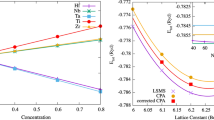Abstract
With the advent of the density functional formalism1, improved numerical schemes, and the steady increase in computational power, researchers are now confidently studying a wide variety of technologically important materials properties which in some cases are not amenable to laboratory observation. In this paper, we survey an all-electron, full potential computational algorithm which employs a compact basis set of Gaussian type function for such studies. In Sec. II, the computationally intensive steps of this problem and recent work-toward reducing the computational complexity, are briefly reviewed2,3. By incorporating a simulated annealing algorithm we are able to simultaneously vary both the linear and nonlinear “electronic coordinates” and, when necessary, bypass the direct diagonalization step. With this formulation, the computational cost increases linearly with the number of atoms in the regime of tens to hundreds of non-identical atoms3,4. This method enables the accurate evaluation of Hellmann-Feynman (HF) forces. In Sec. III through V we present static and dynamic simulations on a variety of lithium clusters ranging in size from two to twenty seven atoms. By way of these examples, we explicitly show how to predict vacancy formation energies, defect induced lattice relaxation, cohesive energies and vibrational phenomena in many-atom systems. In addition, by carrying out calculations on successively larger crystal fragments, we are able to simulate crystal growth and observe the transition from atomistic to bulk phenomena. The cohesive energies, bulk moduli and lattice constants are presented as a function of cluster size and are found to agree favorably with other theoretical and experimental perfect crystal results.
Access this chapter
Tax calculation will be finalised at checkout
Purchases are for personal use only
Preview
Unable to display preview. Download preview PDF.
Similar content being viewed by others
References
P. Hohenberg and W. Kohn, Phys. Rev. B 136:864 (1964); W. Kohn and L.J. Sham, Phys. Rev. A 140:1133 (1965).
M.R. Pederson, B.M. Klein, and J.Q. Broughton, Phys. Rev. B 38:3825 (1988).
M.R. Pederson, “Proceedings of the Third International Conference on Supercomputing”, Vol. I, 179 (1988).
W.E. Pickett, “Proceedings of the Third International Conference on Supercomputing”, Vol. I, 172 (1988).
We use the parametrization of the Ceperley-Alder exchange correlation potential of J.P. Perdew and A. Zunger, Phys. Rev. B 23:5048 (1981).
H. Hellmann, Einfuhrung in die Quantenchemie, (Deutick, Leipzig, 1937); R.P. Feynman, Phys. Rev. 56:340 (1939).
R. Car and M. Parrinello, Phys. Rev. Lett. 55:2471 (1985).
W.H. Press, B.P. Flannery, S.A. Teukolsky, and W.T. Vetterling, “Numerical Recipes: The Art of Scientific Computing”, (University Press, Cambridge, 1986).
C. Kittel, “Introduction of Solid State Physics”, 5th Ed., (John Wiley and Sons, Inc. 1976).
V.L. Moruzzi, J.F. Janak, and A.R. Williams, “Calculated Electronic Properties of Metals”, (Pergamon Press, 1974).
J. Callaway, X. Zou and D. Bagayoko, Phys. Rev. B 27:634 (1983).
M. Mehl and H. Krakauer (unpublished data). For a discussion of the method see S.H. Wei and H. Krakauer, Phys. Rev. Lett. 55:1200 (1985).
Author information
Authors and Affiliations
Editor information
Editors and Affiliations
Rights and permissions
Copyright information
© 1989 Plenum Press, New York
About this chapter
Cite this chapter
Pederson, M.R., Mehl, M.J., Klein, B.M., Harrison, J.G. (1989). Applications of Simulated Annealing in Electronic Structure Studies of Metallic Clusters. In: Vitek, V., Srolovitz, D.J. (eds) Atomistic Simulation of Materials. Springer, Boston, MA. https://doi.org/10.1007/978-1-4684-5703-2_8
Download citation
DOI: https://doi.org/10.1007/978-1-4684-5703-2_8
Publisher Name: Springer, Boston, MA
Print ISBN: 978-1-4684-5705-6
Online ISBN: 978-1-4684-5703-2
eBook Packages: Springer Book Archive




